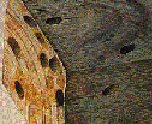Social stinging hymenoptera

Approximately 1/2 inch in length. Their body is black with yellow stripes traversing the abdomen from side to side. Their thorax typically has one or two stripes as well. These insects often build their nests underground, filling cavities that already exist. They have been known to nest in cavities created by mammals (mouse burrows) as well as in or around hollow block, around railroad tiles and inside woodpiles. In the Northeast, German Yellowjackets often nest in wall voids, attics, or crawl spaces. These nests look like an inverted teardrop or odd shaped ball.

This is the largest paper wasp and is the only true hornet in the United States. Its body is brownish and marked with orange. They have a similar type nest as does the yellowjacket.

This hornet (really a type of yellowjacket) is moderately large and has whitish or yellowish marking on the front of the head, between the eyes. The body is basically black. Again, their nests are similar to those of the yellowjackets.

Eastern species of paper wasps are typically a dusky brown color, marked with various shades of orange, or black with yellow markings. Western species tend to have their orange or yellow markings more prominent. Their nests tend to be simple, with a row of open cells pointing downward. They tend to be suspended beneath eaves and window ledges or porch roofs.

Bumblebees generally nest underground. These bees tend to be large, 1 to 1 1/4 inches in length. They are covered with hairs, giving a furry appearance. They are also yellow with a prominent black stripe across the back.

Honeybees can be various shades of yellow, black, brown, or orange, with the head, antennae, legs and a portion of the abdomen being dark. The body is covered with light colored hairs, thickest at the top of the thorax. Workers are usually about 2/3 inch in length.
Non-Social Stinging Hymenoptera

Mud dauber wasps can be distinguished from other wasps because they do not fold up their wings, but instead lay their wings on top of each other in a flat position and lay them on top of their bodies. They are also seen alongside mud puddles gathering mud to build their nests with. They build their nests out of mud. They are usually single celled structures of mud plastered to the walls of structures or on the rafters in attics, garages, or out buildings. Although they are single cell structures, they build several cells side by side.

These wasps can be up to 2 inches long. The body is black and noticeably marked with yellow. They dig nests into the ground, leaving a burrow approximately 1/2 inch in diameter. Soil can be seen thrown out of the nest, leaving a small pile of dirt at the entrance.


Carpenter bees resemble large bumblebees. In the east, the carpenter bee is black in color and marked with areas of yellow hair, but the dorsal sides of the abdominal segments have no area of hair. Other species of carpenter bees will be black, green, or purplish in color, and are variously marked with whitish, yellowish, or reddish hair. They build their nest by boring long tunnels into wood and divide these tunnels into cells, where they leave their eggs and food. There nest is noticeable by the presence of a 5/8 inch perfect hole (as if someone took a drill and made the hole) along with yellowish dropping near the hole. However, as the dropping age, they tend to darken and become black within 6 months to a year. Carpenter bees drill holes into unpainted of badly weathered wood. Therefore, sometimes the entrance hole is not visible. Carpenter bees may squeeze through openings (cracks and crevices) around soffets or facia boards, and nest in the opposite side of the wood, which is usually unpainted. They will, in these situations though, leave behind their dropping.